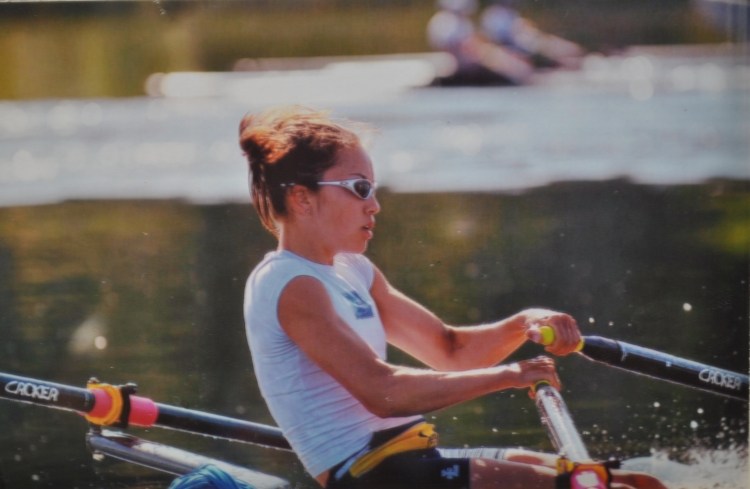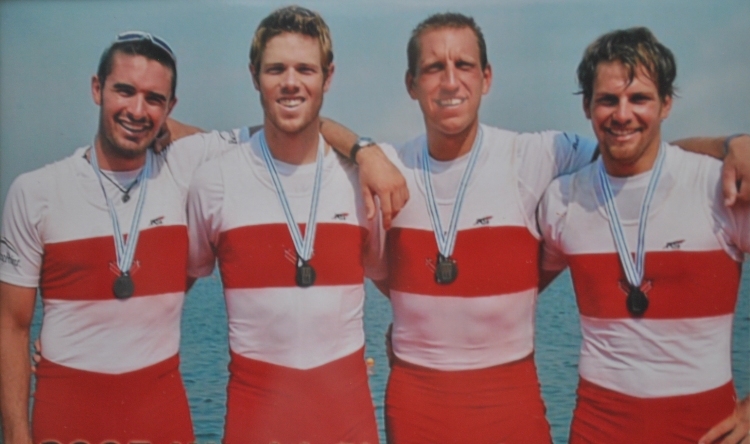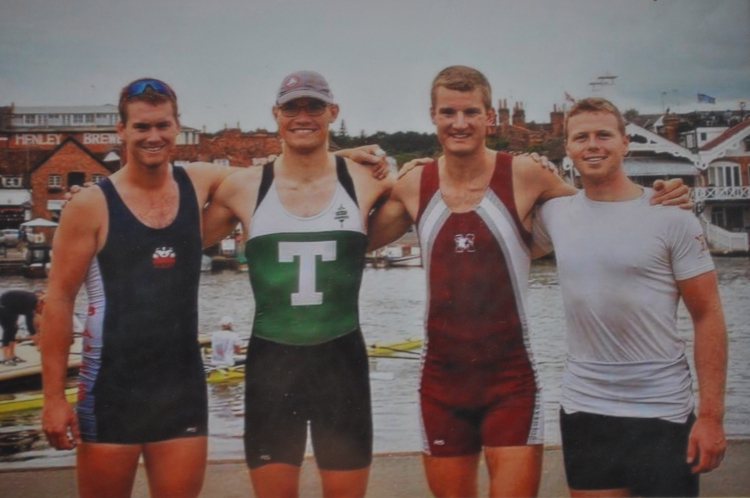What comes next is a bit of a mouth full, but I have created a wonderful acronym to aid you. Damn Winds May Make Leander Jump, Kick And Miffed; this cleaver phrase gives you the last initial of the founders of the club. S. Dumoulin, R. Frost, and A. Muir along with W. McGibbon, G. Long, A. Johnston, E. Kelly, R. Askew, and J. Mahony. The efforts of these men resulted in the establishment of the Leander Boat Club in 1927. Just to be sure that everything was official, they had the club incorporated on 28 May of that year. Acquiring equipment form the defunct Hamilton RC, a new building was erected at the foot of John Street. The club grew rapidly and achieved great successes in its early days, winning the 150lb. eights at Henley in their first season.
Leander crews raced and won the opportunity to represent Canada at the first British Empire Games in 1930 (Bronze) and four consecutive Olympic Games: Los Angeles (1932 – Bronze), Berlin (1936), London (1948), and Helsinki (1952); A Leander crew was also chosen to race at the 1940 games but Hitler, having seen them race in ’36 and not wanting his boat to loose had different plans!
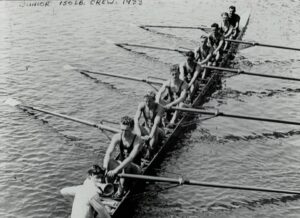 On 19 July 1932 the Leander eight of Taylor, Boal, Thorburn, Liddell, Fry, Stanyar, Harris, Estwood, McDonald (cox) caused a stir as she sped her way to victory at the Olympic Trials over the favoured Argonaut crew only eleven days before the opening ceremonies in LA. The New York Times reported that “They left the Toronto Argonauts, who represented Canada at the Amsterdam Games in 1928, a length and a half behind to win in the amazing time of 5 minutes 29 4-5 seconds – the fastest time ever recorded in North America.” Not wanting to be ungrateful guests and potentially anger their hosts the Leander men contented themselves with bronze allowing the Yankee eight to take the prize.
On 19 July 1932 the Leander eight of Taylor, Boal, Thorburn, Liddell, Fry, Stanyar, Harris, Estwood, McDonald (cox) caused a stir as she sped her way to victory at the Olympic Trials over the favoured Argonaut crew only eleven days before the opening ceremonies in LA. The New York Times reported that “They left the Toronto Argonauts, who represented Canada at the Amsterdam Games in 1928, a length and a half behind to win in the amazing time of 5 minutes 29 4-5 seconds – the fastest time ever recorded in North America.” Not wanting to be ungrateful guests and potentially anger their hosts the Leander men contented themselves with bronze allowing the Yankee eight to take the prize.
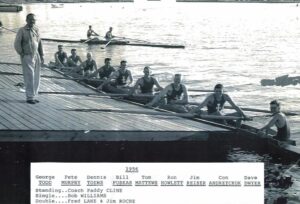
Since the establishment of national composite crews Leander has had at least one rower on the team every year, often many more beginning in 1972. In 1985, seven of twenty-five rowing members were selected to row for Canada at the Worlds in Belgium. Form 1931 Diamond Sculls winner Bobby Pearce through world and Olympic champions Mel Laforme (1985), Andy Crosby and John Wallace (1992), Joe Stankevicius (2002 & 2003) and Al Morrow’s uncountable contribution to the medal count as national women’s coach, Leander has and continues to house and develop the very best in the world.
There are far too many victories, too many deserving men and women to properly recognize in this short history so we must move on.
In December of 1941 a devastating fire destroyed half of the boat house and all of the equipment. The second blaze of November 1949 gutted the steward’s room and dancehall; the boats, however, survived the flames in their new shed.
It may have been the sinking club house – or was it the cancellation of the lease and government plans to redevelop the land as a warehouse? – But it was decided that Leander must relocate. There is no doubt that numerous meetings ensued through which the aesthetically pleasing cinderblock design won the approval of all. In 1962, under the presidency of Claude “Sandy” Saunders the club moved half a mile west to its present location at the foot of Bay St. The new building’s rowing, social, and change room facilities were reported as among the best in the country and remain in their glorious sixties splendour to this day.
 In 1877 on the pilings at the end of Bastine’s Dock at the foot of Peel Street, the Leander Rowing Club was born. This is not to be confused with the Leander Boat Club of current fame. The greatest Hamilton club of the age, the ‘redoubtable’ Nautilus Club was established the following year by local glassworkers. One can only assume that this was because they didn’t want to row at Leander. After some years the former decided to shut up shop and ceased operations in 1895: the Nautilus men, not willing to be out done did likewise. Thinking it a good idea to have another try at the oar the Hamilton Rowing Club moved into the old Leander boathouse in 1900. Wanting a change of scenery in 1907 – primarily due to a disastrous fire – the club relocated to the power house at the foot of James Street. This club followed the path of the previous two and folded in 1925. Hamiltonians, however, would not have to wait long for yet another rowing club to take up the flame.
In 1877 on the pilings at the end of Bastine’s Dock at the foot of Peel Street, the Leander Rowing Club was born. This is not to be confused with the Leander Boat Club of current fame. The greatest Hamilton club of the age, the ‘redoubtable’ Nautilus Club was established the following year by local glassworkers. One can only assume that this was because they didn’t want to row at Leander. After some years the former decided to shut up shop and ceased operations in 1895: the Nautilus men, not willing to be out done did likewise. Thinking it a good idea to have another try at the oar the Hamilton Rowing Club moved into the old Leander boathouse in 1900. Wanting a change of scenery in 1907 – primarily due to a disastrous fire – the club relocated to the power house at the foot of James Street. This club followed the path of the previous two and folded in 1925. Hamiltonians, however, would not have to wait long for yet another rowing club to take up the flame.



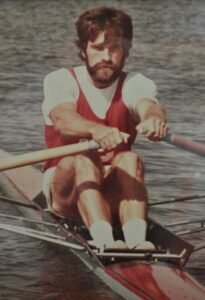 It was the 1970s that saw the greatest changes at the club. There was no fire, the lease was not cut short, the building remained as it still does, so what’s all the fuss about then you say? Women! Yes, women were finally allowed to row and row they did.
It was the 1970s that saw the greatest changes at the club. There was no fire, the lease was not cut short, the building remained as it still does, so what’s all the fuss about then you say? Women! Yes, women were finally allowed to row and row they did.